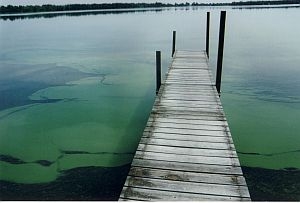
(Host) Everyone agrees that Lake Champlain has too much phosphorus pollution.
And there’s strong consensus that despite decades of work and millions of dollars spent, the lake is showing little improvement.
But what to do about it?
In the second of two parts, VPR’s John Dillon explores some of what’s being done to try to clean up the big lake.
(Dillon) Phosphorus is the main problem. It’s a nutrient that acts as fertilizer for the toxic algae blooms that choke the northern bays.
Vermont’s environmental agency is focused on stopping the non-point phosphorus pollution pouring into Lake Champlain.
It’s in the stormwater that runs off thousands of city streets, or it’s contained in the manure washing from farm fields.
Research this summer is aimed at pinpointing these pollution sources. Julie Moore directs the state’s clean and clear program. She says the state will use sophisticated mapping and aerial photography to identify phosphorus hot spots.
One technique uses laser-based imaging technology called LIDAR that can detect changes in elevation as small as six inches.
(Moore) “What you’re really looking at with LIDAR data is kind of micro topography. So real small-scale features. The information we have right now generally has 10 by 10 meter pixels so it takes all of the information in a box that’s 10 meter square and it averages it out. So you can see you won’t capture these little forms like ditches or rills and gullies of erosion.”
(Dillon) The new images get much, much closer.
(Moore) “We’re looking at areas maybe the size of this table top. So you can get a much better sense where there is rill and gully erosion and very specific landscape features. It also has a lot of application in the urban environment.”
(Dillon) This research – coupled with more traditional aerial photography – should identify unknown and uncontrolled phosphorus sources.
But officials already know where a lot of phosphorus comes from – and that’s from farm operations.
So the state is helping to design systems for farms to better management manure and milk house waste. Often these involve containing the waste in large pits for use later as fertilizer.
(Moore) “We currently have about 20 farms with active projects, and most of those farms have somewhere between three and six projects each that are being designed.”
(Dillon) But the state hasn’t made much headway on the non-point front. The Agency of Natural Resources is years late in cleaning up Chittenden County streams eroded and polluted by urban run-off. The damage happens when water rushes off paved streets and parking lots and gouges out the stream channel, sending more phosphorus-laden sediment downstream.
And the problem is getting worse, because — as the population grows – more acres are paved over. A University of Vermont study found that 53 percent of the phosphorus now comes from urban land. That’s a big jump from 1999, when research found that 39 percent came from urban sources
Moore says a state stormwater scientist is working this summer with the city of St. Albans to control urban run off. These systems usually involve retention ponds that trap and then slowly release the dirty water over time. The state is looking for grants and hopes to start work next year.
(Moore) “The idea there is to get to places that didn’t have stormwater permit requirements when they were built and look for opportunities to put in a project that can address a significant amount of currently uncontrolled stormwater. And there are a couple of those projects in the works.”
(Dillon) But there’s another phosphorus source that the state is not doing much about – and that’s the stuff that comes straight from sewage treatment plants.
The state says just 10 percent of the phosphorus coming into the lake comes from sewage. So officials want to focus on the non point sources.
But environmentalists question the state’s focus – and its numbers. Mike Rapacz is a science consultant working for the Conservation Law Foundation, a regional environmental group.
(Rapacz) “Definitely turbulent. It’s the delta building. You can see that.. Is that.. No that’s floating. It’s pretty shallow here I bet. We shall find out.”
(Dillon) Rapacz uses a small motor boat to offer a guided tour of the lake’s dirty water. Near the mouth of the Winooski River, the lake is brown and visibility in the water is down to a couple feet.
Rapacz says no one knows how much phosphorus comes from sewage plants – because they routinely release raw sewage during storms or spills.
(Rapacz) “Because.. , if you look at the monthly reports on spills or combined sewer overflows, most of them have no number associated with the volume which has been discharged to rivers or streams. So they don’t even know what the volume of water is that’s been illegally discharged as a spill.. So the 10 percent number to me is fiction.”
(Dillon) The state reports show almost daily spills or overflows as the plants were overwhelmed by heavy rain. For example, on July 18, the St. Albans sewer plant twice dumped untreated sewage into a stream.
Two days later, Vergennes released untreated sewage, followed later in July by the towns of Middlebury and Proctor.
Christine Thompson directs the wastewater management section for the Agency of Natural Resources. She says the basic solution is to separate storm drains from sanitary sewers so the rain doesn’t overpower the system.
(Thompson) “It would be huge projects in many of the cities. … And they would have to get bond votes passed for it. And that would a difficult one to sell to the citizens, I would think.”
(Dillon) The state recently ordered one chronic polluter to clean up its act. The town of Proctor is under orders to fix its system by September of this year.
For VPR News, I’m John Dillon.